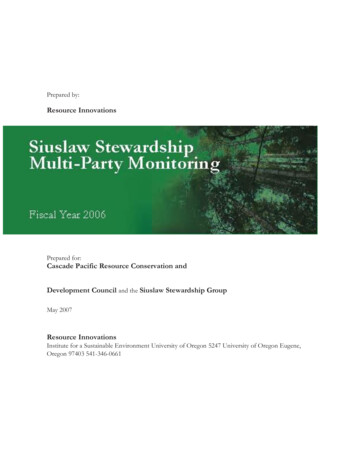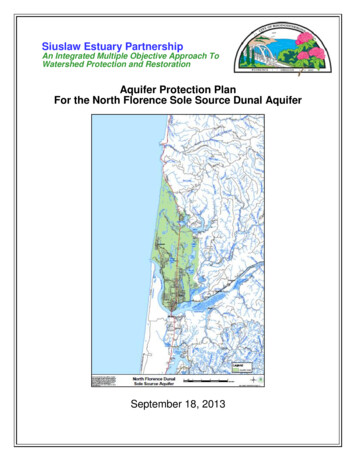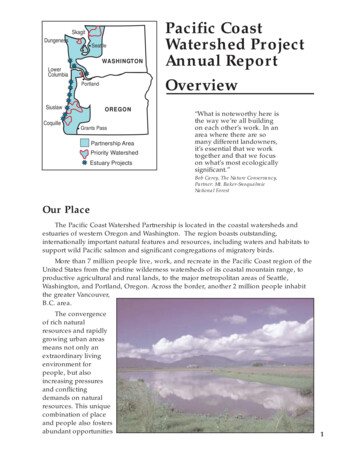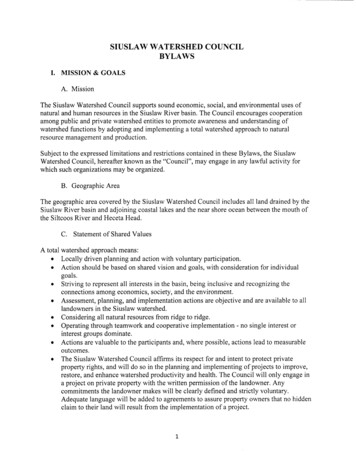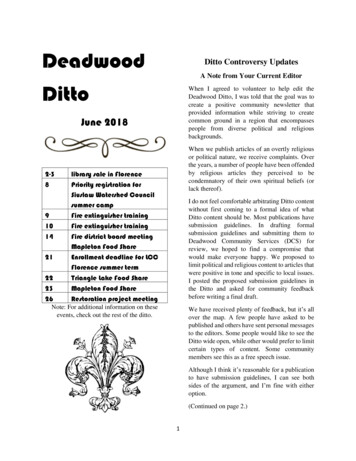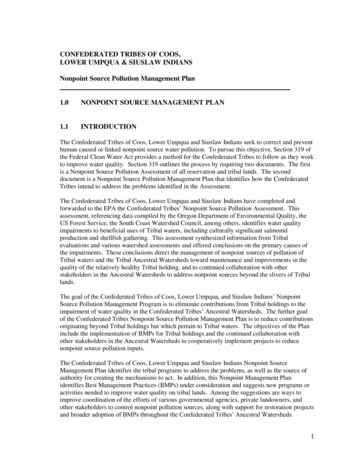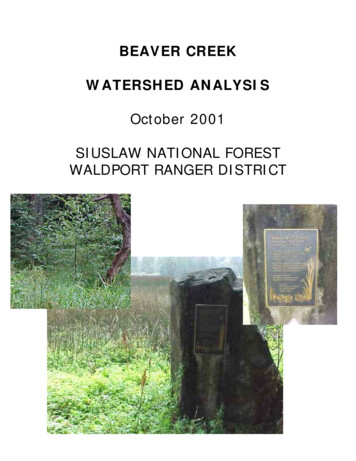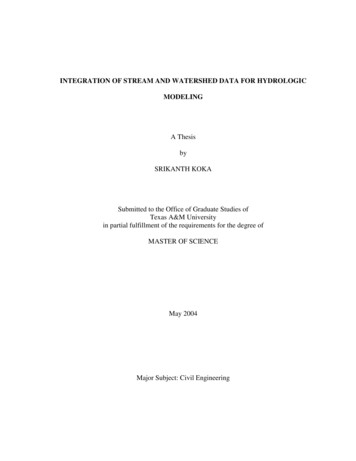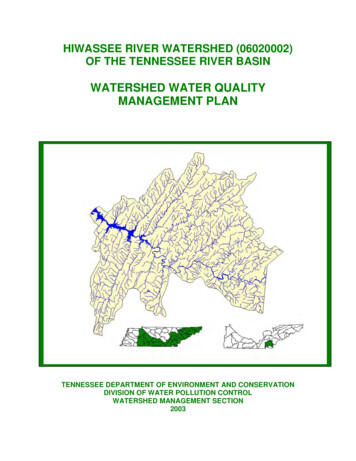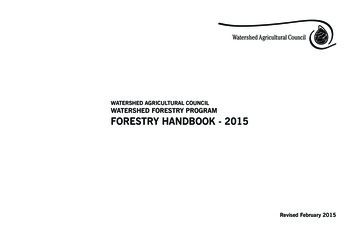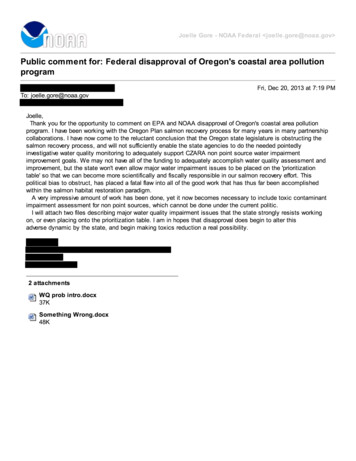
Transcription
Siuslaw watershed, mid coast OregonIntroduction to impaired waters problem:We have very good quality water in general, and we have a lot of it in mid coast watersheds. However,there is very low availability of exchangeable calcium carbonate to buffer acidification events, comparedto waters in most of the rest of the nation. Common water hardness range is 8 to 24 mg/l CaCO3.This low CaCO3 level appears to be getting worse than in the prehistoric conditions that the streamorganisms had become adapted to.Low calcium waters are at much higher risk of increased frequency and severity of acidificationpressures causing episodically lower pH and exchangeable CaCO3 dips.These low-calcium events tend to push stream organisms outside of their preference range for calciumavailability, placing them at higher risk of pathogenic hypocalcemia.This causes assemblage shifts in stream populations, altering the ecology. This may relate to proposedbiocriteria listings for macroinvertebrate assemblage shifts (as seen in PREDATOR data for the Siuslaw).Many acidification pressures are anthropogenic: Reduced marine-derived nutrient CaCO3 from reduction of spawning salmon and lampreyreturns.Atmospheric CO2 increaseRed alder percent vegetation cover increase, while red cedar cover has been greatly reduced.pH and CaCO3 dips mobilize calcium utilization-inhibiting metals increasing pathogenicity.This anthropogenic pathogenicity alters salmon ecology, causing reduced salmon-supportivespecies.Low calcium events increase corrosivity of stream waters to metals.Non point pollutant sources of toxic metals increase pathogenicity to salmon.The toxic metal lead is an anthropogenic threat to salmon in low calcium waters.We have several major sources of toxic lead that pollute our salmon streams in the Siuslawand other low calcium high risk watersheds. Leaded gasoline was a major source that is now greatly improved. Dissolution of huge quantities of lost lead fishing sinkers, boat anchors, and bullets is amajor ongoing source. They get ground up in the mortar and pestle action of riverinepotholes to exponentially increase surface area exposed to low calcium waters, and fineparticulate can contact sensitive gill and gut tissues.1
Seven heavily degraded railroad bridges on the Siuslaw River pollute waters with hugequantities of toxic lead and other toxic metals via leaching and fine particulate flakesflushing to pollute high priority salmon habitat. A single stream of water running off ofone of the bridges was contaminated with sixteen thousand times the water qualitycriterion, one rivulet off of one bridge. Dissolution of metals from culverts contributes to pollution of high priority cool waterrefuge for salmon and supportive species. pH dip severity and frequency episodically increases potential for toxic aluminummobilization from soils and from anthropogenic sources in the streams. Legacy lead and copper birdshot, littering the estuary mud, adds to the toxic metalpollutant sourcing and pathology when copious leaching rains run off of contaminatedbay mud at low tide.Toxic metal pathogenicity is a generally ignored limiting factor for salmon population recoveryin mid coast low calcium watersheds. This non point source metals threat does not show up in 303d listings by any state orfederal agency responsible for water quality assessment and salmon populationrecovery effort. Regulatory agencies studiously ignore any suggestion of water qualityimpairment from these sources because of fear of censure from the state legislature. This omission is scientifically, ecologically, and fiscally irresponsible while we do notprioritize for adequate monitoring, assessment, and mitigation of these threats. Wehave a great opportunity, to save us a lot of money, if we identify and clean up some ofthese sources that impair beneficial uses of our waters, the political bias is based onshort term avoidance to the detriment of long term gains. We must reduce toxic metal inputs to these low calcium high risk waters. We must reduce anthropogenic freshwater acidification pressures, yet we don’t evenplace them anywhere on the prioritization ‘table’ to be considered. Something is wrong.Scientific and fiscal responsibility for sustaining our future is being stymied by anunsupportive state legislature. Monitoring funding for these ignored limiting factors is effectively held back by waterquality responsible agencies because such pointedly investigative assessment is seen asinherently politically subversive because the agencies are inadequately supported by2
the state legislature and the Environmental Quality Commission to do pointedlyinvestigative toxic pollutant assessment on a site-specific basis. We cannot claim ‘best available science’ as a basis for our salmon recovery effort whilethis paradigm blocks our toxic pollutant assessment as it applies to salmon recovery,aquatic health, and human health in the low calcium high risk waters of the mid coast. The Oregon Department of Environmental Quality needs to be enabled by thelegislature and EQC to fulfill its purpose in protection of all residents fromenvironmental toxic contaminants. The current IRTMDL process will not adequately define mid coast water quality statusand trends, since it ignores low calcium associated pollutant risks to aquatic health inmid coast waters. Additional state and federal assessment is essential to salmon recovery effort andaquatic health attainment to support all beneficial uses in these watersheds. The ecosystem service values, provided by clean water, far outweigh the costs ofmonitoring in a true cost/benefit assessment. We could save vast amounts of money ifwe placed these water quality issues directly onto the ‘prioritization table’ rather thansticking our heads in the sand while pretending they do not exist. A large body ofscientific literature supports pointedly investigative assessment of these non pointsource pollution issues.The enclosed opinion papers attempt to clarify the need for addressing prioritization of thesenon point pollutant sources that impair our mid coast aquatic health and beneficial uses of ourwaters. The papers have a lot of redundancies, since they were reports for projects withdifferent goals, funded from different sources, or unfunded volunteer work.Most of the water chemistry data that drives these concerns was collected from 1994 to 2004.A targeted project, the Lake Creek Lead Assessment Project (LCPbA), was done in response toinitial Siuslaw Soil and Water Conservation District water sampling that indicated concern thatdissolved and total recoverable lead levels appeared to be elevated frequently in the lower partof Lake Creek which is the major tributary to the Siuslaw River. This study concentrated on amile long stream segment a couple of miles above the confluence with the Siuslaw. Data fromthe project suggested that indeed there were frequent elevated lead levels in the water. SWCDwork in ’98 and ’99 included continued effort to get ODEQ to come down to sample some of thewater using their own methodologies to clarify if there was a level of concern on their part. Anaccount of this effort is included in the enclosed papers.3
Increased concern by the SWCD and the Watershed Council led to inclusion of a follow-upstudy to the LCPbA study with EPA funding for the Siuslaw Watershed Restoration Initiativethrough Ecotrust and the Siuslaw Watershed Council. This project was the Siuslaw River MusselStudy (SRMS). The study focused on the declining health and populations of freshwater musselswithin the stream segments that had shown elevated lead levels in previous studies.The SRMS study indicated concern that mussel populations were very likely being adverselyaffected by the nonpoint source issues of concern that now included elevated lead pollutionfrom seven badly degrading railroad bridges that are leaching huge quantities of leadcontaminated paint into the Siuslaw mainstem below the LCPbA study segment. This discoveryadded greatly to our concern for water impairment from lead sources and associated freshwateracidification pressures locally.In addition to the electronic versions of the main studies conducted so far, I have includedopinion papers of concerns of perceived apparent ODEQ methodology insufficiency inassessment of hardness dependent metals data through the years, which appear to becontinuing to the present. If these concerns prove to have merit, it would bring into questionthe accuracy of 303d determinations for Clean Water Act listings of impaired waters in the Stateof Oregon for hardness-dependent toxic metals in low hardness waters that are sensitive forlisted species.The current IR-TMDL process will not include any of these water quality concerns adequately.One of our concerns is that the current IR-TMDL not be seen as the definitive water qualityassessment to guide future funding prioritization in mid coast watersheds, because suchimportant nonpoint source issues for hardness dependent metals have not been included todate, and appear to us to be essential to assess as soon as possible, if we hope to claim ‘bestavailable science’ for our work for aquatic health and salmon recovery in these watersheds.We may not have enough money available currently to deal with all of the contaminant issueswe have identified, but we must insist on having enough scientific and fiscal integrity to be ableto place all issues squarely onto the prioritization ‘table’. As natural resource managers, weneed to face the water quality reality in the field. We are not playing with a full deck of cards ifpolitics prevents adequate collection and assessment of data on these issues. To the degree thatwater quality criteria and standards are not correctly applied for hardness-dependency ofidentified nonpoint pollutant metals, resource management fiscal and scientific integritybecomes misinformed and more subject to prioritization errors, with subsequent lostopportunity for aquatic health improvement in a cost effective manner. Salmon, lamprey, rivermussels, and supportive species continue to decline. We have to question ourselves, and wehave to question authority if we hope to be effective in time.4
Quality Water, Quality LifeWater quality perspectives in the Siuslaw watershedOn the mid coast Oregon salmon streams I live on, the rainy season has begun again. Rains drench the forest,the clearcuts, the roads, and the railroad bridges. Copious rainfall flows over and through all of these surfaces andinto the streams of the salmon.The prehistoric salmon habitat had long supported massive salmon and supportive species populations. Historichabitat degradations have greatly reduced aquatic health and salmon returns. Many local residents are workingvery hard, at great personal cost, to improve salmon habitat and aquatic health. Long hours of unpaid work arelogged by thousands of volunteers working alongside of paid professionals. Together, we have done more than Ihad thought possible. We are encouraged, and challenged, to improve our effectiveness.Our effectiveness is dependent on the quality of the questions we ask. Science advances by evaluating evidenceand improving the quality of questions. Dedication to a scientifically questioning attitude leads more effectivelytoward salmon recovery. Facing difficult questions is at the heart of our work. Many millions of dollars are spenton the recovery effort. It is fiscally, and ethically, irresponsible to neglect to ask the tough questions thatenvironmental investigation suggests during our work. This public opinion paper attempts to address thisresponsibility.Species are going extinct at an alarming rate. Aquatic species are declining about five times faster than terrestrialspecies. We work under great pressure for timely aquatic health improvement, or the beauty we have known willnot be adequately passed to our great grandchildren. There is a need to improve the quality of our questionsquickly. We need it as a top priority as our biggest challenge in salmon recovery effort. If we sit in our meetingsand work in the field while we avoid asking the tough questions, we will not be in time. This opinion paperrespectfully offers to bite the existential bullet toward advancing the quality of our questioning in a timely fashion.Mistakes are inevitable but our understanding needs to advance more quickly, and will, if we cultivate aquestioning attitude in our work. The resultant surge in creativity will carry us through to expand ourunderstanding and adaptive effectiveness with better scientific integrity.Pointedly investigative water quality monitoring and assessment is inherently politically subversive, yet it isabsolutely essential for aquatic health and salmon population recovery.National politics pressures EPA and NOAA to avoid any meaningful environmental assessment of the toxic metallead as a contaminant pollutant in our mountains and salmon streams for fear of political power from the NationalRifle Association and industry. The NRA actively seeks legislation barring the agencies from pointed environmentalinvestigation of lead. The NRA is a huge lobby and carries a lot of political clout. The politic biases the agenciesresponsible for water quality assessment toward ignoring the wealth of toxicologic science that implicates toxiceffects of lead as another limiting factor for salmon population recovery in high risk watersheds of the Pacificcoast.Almost everyone in these agencies came out of college with a desire to help better our world with qualityenvironmental assessment, scientific integrity, and water quality improvement. Agencies are staffed with bestintentioned people, yet the political arms of each agency are cowed under the national political pressures from theNRA, mining, and military/industrial anti-investigatory lobbies. National politics bows to this environmentallymisdirected power. Pointedly investigative environmental assessment is therefore now inherently politicallysubversive. Agencies dare not fund needed assessment enough to make any ‘waves that could swamp the agency5
boat’ lest funding could be punitively cut for other work that they are still able to get done for the environment.This anti-investigatory paradigm is a huge blocking boulder in the stream of salmon recovery effort to providesupportive aquatic health. State environmental quality departments need state legislative support to enablescientifically responsible ecologic water quality assessment for aquatic health and salmon recovery. The state musttake a stand for the health of all residents and for the beauty we have the responsibility of passing to our greatgreat-grandchildren. Fiscal responsibility should require scientific integrity that cannot be obtained without waterquality monitoring integrity to the best of our ability. “Best available science” claims for our current salmon habitatrestoration cannot legitimately be made without freedom to investigate adequately.Any freshwater aquatic health assessment work for salmon recovery should strive to keep in mind that we aredesperately trying to clarify what the aquatic reality actually is, from moment to moment, for organisms in riversand streams. Changes we cause in water quality all affect their ability to thrive. The more changes we introduce,the more pressures we put on them to adapt to those changes quickly enough to avoid decline. Their plasticity andresiliency is challenged by the accumulative pressures to adapt. Decline pressures have been accumulating fasterthan the ability to adapt adequately evolves. It’s impossible to fully grasp the environmental complexity they face,but our success depends on our clarity of understanding.We have a very poor understanding of pollutant effects (what we do know is alarming), yet they are pervasivethroughout the salmon life cycle. As natural resource managers, we desperately need more clarity and increasingability to detect, understand toxicologic implications, and to reduce toxic degradations of aquatic health. Adequatemonitoring is essential to understanding pollutant impacts. Monitoring costs, however, all of the beneficial valuesof the totality of ecosystem services provided by aquatic health far outweigh costs of monitoring. Any accuratecomprehensive cost/benefit analysis would demonstrate the essential nature of the economics of water qualitymonitoring. We cannot hope to adequately do our work without greatly increased monitoring that will provide theclarity to adaptive water quality and aquatic health improvement for the salmon and other ecosystem services.Yet, the natural resources management imperative for monitoring remains under illogical attack from theindustrial/military politic that creates the novel chemicals fueling our carcinomorphic rush to consume our worldwith uncontrolled growth. Aquatic monitoring is seen as antagonistic to this cancerous growth paradigm.Adequate monitoring is reduced by the politic that supports this carcinogenicity. In biology/ecology, growth has tobe paid for, aberrant growth becomes too costly and the system self-regulates, reducing carcinogenic pressure.Society is illogically becoming more antagonistic to uncontrolled growth regulation, tipping the balance intocarcinogenicity. Aquatic, pointedly investigative pollutant and health monitoring is essential, but unsupported bythe politic, and is seen as inherently politically subversive. As the cancer grows, it inhibits monitoring of its wildgrowth. This is the pathogenic paradigm facing our salmon restoration and aquatic health imperative.Figuring out how to adequately fund our essential aquatic monitoring is highest priority. Metastatic invasion intoagencies with water quality regulating responsibility politically down-regulates pointedly investigative monitoringand science in general in favor of ‘political science’ rather than ecologic science, necessitating federal oversightdriven by law suits.We can no longer expect adequate support for our efforts from these agencies as currently configured. Ourfunding for this work will have to come from other sources. The sooner we come to understand this, the soonerwe can adapt in support of aquatic assessment and aquatic health. Quickly recognizing how we can acquire ourmonitoring capacity is a most important key to our effort. The Oregon State Legislature is blocking state agenciesfrom properly investigating these pollution issues. Federal regulatory agencies are being pressured by lawsuits topush the state to take a more tenable action toward reducing impaired waters on the Oregon coast. The suits do6
not go far enough to also encompass toxics contaminant water quality impairment in these ESA coho listed priorityhabitat. The Total Maximium Daily Load (IRTMDL) by ODEQ ignores the toxic contaminant issues in mid coastwatersheds.Toxic contaminant risks impair waters and salmon population recovery.Given: Low dose waterborne copper cilia damage of apical neuronal sensory organs, with subsequent loss ofsurvival abilities and resultant mortalities in salmon populations:(See: Nat Scholtz et. al. NOAA Fisheries contaminants in Seattle)Does copper also similarly damage other water-exposed cilia (e.g. gut mucus train/crystalline style cilia offreshwater mussels)?Since copper causes these epithelial lesions, and the toxic metal pollutant lead is also known to cause epitheliallesions (via lipid peroxidation of membranes, thus causing perforated protective membranes such as the bloodbrain barrier as well as external membranes), if Pb and Cu are co-contaminants in water (e.g. stormwater runoff),do the resultant lesions at the apical sensory neurons allow pathogenic entry of elevated Pb and Cu into theneurons?If so, is retrograde axonal transport of these neurotoxic metals a pathogenic mechanism to neuronal centers offish (e.g. coho salmon young, and freshwater mussels)?So, if olfactory, ocular, and lateral line apical neuronal entry can be neuropathologic for coho salmon presmolt,are the levels of toxic metals seen in mid coast Oregon low-calcium salmon streams high risk for neuropathicdegradative, sublethal, effects for cognitive damage? Does this impair sensory and learning abilities that result infood acquisition and predator avoidance behavioral deficits with subsequent coho population decline pressures?Does this same mechanism of toxic metal contaminant neurotoxicity contribute to the freshwater rivermusselhealth and population declines in waters associated with identified anthropogenic non point source metalpollutant sources in these low-calcium waters on the mid coast?Since, these metals are hardness-dependent for Clean Water Act water quality criteria and standardsdetermination formulas, are the proper ODEQ/EPA-required data assessment protocols applied for all hardnessdependent metals data in low-calcium western Oregon salmon habitat waters?Is ‘percent exceedence’ appropriately, or inappropriately, used at times to limit 303 d listing determinations?Is funding prioritization improperly used often to limit field resource manager water quality assessment and datagathering, in order to keep suspected non point sources starved of data that could show impairment of waters andbeneficial uses reduced?If erroneous assessments for 303d listings are a common occurrence, are we being scientifically, ethically, andfiscally irresponsible in not identifying and correcting these CWA possible violations?Have natural resource managers, prioritizing for salmon recovery, been continuously misled for decades aboutmetal pollutant effects on salmon decline as a limiting factor for salmon recovery by inappropriate state agency303d assessment?7
Lead, cadmium, mercury, and zinc are commonly found in tissue samples from the Lake Creek and Siuslaw Riversites that are associated with major metals pollutant sources that are ignored within state planning for salmonrecovery effort. These metals are well known to be calcium utilization inhibitors. If a unique water qualitycondition, of very low availability of exchangeable calcium carbonate, yields low buffering capacity which causesincreased mobilization of metals sources in the water during pH challenge events, is this water quality conditioncausing river mussel shell erosion, via dissolution, to degrade shells to the perforation stage and subsequentpremature mortality of all age classes? Do subsequent lower dips of CaCO3 and pH also affect coho salmonpresmolt as they migrate toward the ocean phase of their life cycle?Does the high level of anthropogenic sourcing of Pb on the middle and lower Siuslaw River become bioavailableenough to contribute strongly to coho salmon decline, (an ESA listed species)?An extensive scientific literature indicates that it does constitute a very significant risk. Fieldwork completed todate indicates high pollution rates from these toxic metals. Furthermore, the risk potential of dissolvedwaterborne Pb is well recognized in fisheries toxicology, yet research also indicates that it may not have to evendissolve in water to have toxic effect. Colloidal phase elemental Pb particulate, and Pb dissolved with subsequentbinding to organic and inorganic colloid poses risk of direct contact of Pb with sensitive gill and gutmicroenvironments that are more acidic and can dissolve the Pb on tissue contact for increased dose.The literature documents many other toxic effects of metal exposure to fish that affect their physiology andecology from toxic metal anthropogenic NPS pollutant sources in the Siuslaw watershed. These metal sourcesresult in impairment of water quality, yet do not show up on 303d listings or other adequate advisories from waterquality responsible state or federal agencies.We all pollute waters of the state, only some of us get caught and fined. Severity and frequency of our pollutionvaries greatly. Some of us pollute more than others do. ODEQ ‘busts’ some of the polluters that become tooobvious. Lists of those found to have polluted our waters are routinely published, along with the amounts of thefines imposed. Significant amounts of money are gathered regularly.However, ‘an elephant in the room’ is the state imposed double standard that perpetuates pollution by its ownhand. State government routinely supports polluting practices and regulations that allow additional pollution andimpairment of waters, without ever reporting this pollution to the EPA or NOAA or adding any of it to 303d lists.This apparently violates Clean Water Act intent and the law. State fishing regulations enable continued massivepollution of salmon waters, including listed coho essential habitat. Publically owned railroad bridges massivelydegrade and pollute coho waters while tons of lost lead fishing sinkers and boat anchors are allowed to be addedto our streams every year, for many decades. This allows sport fishers to contaminate their hands, their lunches,their boats, the mucus on the fish, and their families when the contaminated fish goes into the frying pan at home.None of this water pollution ever shows up on 303d lists, and EPA does not enforce reporting. The state does notlook at its own causative NPS pollutant actions. Monitoring is discouraged during prioritization, and this massivepollution is not acknowledged by the state. This is systematically, institutionally ignored by state agencies for fearof censure by the Oregon State Legislature. During prioritization for monitoring funding, no mention is ever madeof the importance of these sources by ODEQ. If the subject is brought up, ODEQ says that there is no data thatdemonstrates that there is a problem, and that is why they don’t prioritize any funds to do any adequate datacollection; a real ‘catch 22’, and double standard. While the state specifies very high QA/QC and very difficult,involved, ultraclean sampling and lab work for any outside investigative monitoring of the pollution they areresponsible for, ODEQ readily ‘busts’ others that they discover are polluting. For these ‘busts’ and fines, they do8
not even require that actual water quality monitoring be done by the state to definitively determine that the waterquality pollution has actually impaired the waters. It is just assumed that non government polluters have impairedthe waters by their actions. One definition used for government, another for non government.The state consistently avoids adequate systematic assessment of actions that they cause either directly,indirectly, or allow to continue with very little investigation, assessment, or regulation. Almost no monitoring fundsare allowed to be prioritized for salmon restoration efforts that seek to indentify and mitigate these governmentassociated pollutant sources.ODEQ needs to become enabled by the state legislature and EQC to become pointedly investigative of toxicimpairment. Subsequent CWA violations through any erroneous 303d listing assessments that may have takenplace, or are continuing, involving hardness-dependent toxic metal sources identified by salmon restorationnatural resource advisors and practitioners need to become clear.Mitigation of the highly toxic non point source metals pollution problems is essential for aquatic health andsalmon recovery.Does the State of Oregon Department of Environmental Quality mislead natural resource managers, workingfor salmon recovery, by erroneously applying the wrong water quality criteria formulas for criteria exceedencedeterminations that drive 303d listings to the EPA for federal Clean Water Act requirements, and overall intentof the Act? Or, do they apply correct formulas and assessment? It appears that this avoidance is part of theagency resistance to high quality water quality assessment of impaired waters of the state.If incorrect assessment is done, what changes need to be made to 303d listings, TMDL processes, toxic reductionstrategies, and legal assessment of pollutant violation enforcement programs?If 303d lists inaccurately depict mid coast low-calcium salmon habitat risks from the toxic metal non pointsources identified, how will the state correct assessment of impaired waters to improve the prioritization of fundsfor a salmon recovery effort that should become ecologically, scientifically, ethically, and fiscally more responsibleif we are to hope to be successful in time?Pointedly investigative water quality monitoring would SAVE us money.Fisheries biologists recognize that the Siuslaw watershed has historically supported one of the largestanadromous fish production capacities for its geographic size on the Pacific coast, while some runs are now lessthan ten percent of their historic levels. If the fishery decline can be reversed and aquatic health improvedanywhere in western Oregon streams, it most likely would be on the Siuslaw. There are no significant dams, theproximity to the ocean leaves relatively little pollutant exposure, it receives a huge amount of rain to dilute whatpollutants are present, and the benevolent marine airflow reduces, but does not eliminate, the exposure toatmospheric pollution. However, in spite of this relative geographic and anthropogenic simplicity, a large numberof scientifically relevant questions arise about the pollutant exposures that we do have in the Siuslaw watershed.In-depth water quality analysis is essential to watershed aquatic health assessment if we are to balance resourcebeneficial use with resource sustainability.The imperative for water quality assessment in the salmon recovery and conservation paradigm conflicts withthe sociopolitical reality that pointedly investigative water quality assessment is inherently politically subversive.State legislatures don’t want to have to find more funding to fix any additional aquatic environmental problemsthat might come to light with increased monitoring. Agencies responsible for water quality assessment andimprovement are caught between a rock and a hard place,
Siuslaw watershed, mid coast Oregon . Introduction to impaired waters problem: We have very good quality water in general, and we have a lot of it in mid coast watersheds. However, there is very low availability of exchangeable calcium carbonate to buffer acidification events, compared to waters in most of the rest of the nation.
